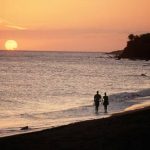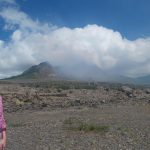Destination of the week
 St Patrick’s Day in the Caribbean Montserrat
St Patrick’s Day in the Caribbean Montserrat
By Mary Barber From Independent IE
The Caribbean island of Montserrat stamps visitors’ passports with a picture of a shamrock to illustrate how many of its citizens have Irish ancestry
‘ST PATRICK’S village was wiped out,” said our guide James ‘Scriber’ Daley. “The volcano took everything. Our homes and school, they all went, there was nothing left except what was floating in the sea. What you see is a modern day Pompeii.”
The palm tree-lined hamlet on the southern tip of the tiny Caribbean island of Montserrat lay buried beneath millions of tonnes of ash and rocks. Any features of a familiar landscape were gone. It was now a vast grey wasteland.
People on board the heritage boat tour pointed to where they thought their homes used to be. Some were in tears while others stared in disbelief. Next to me on the deck was Yvette Stoute. It was the first time the married mother-of-three from Montserrat, who now lives in Texas, had seen the devastation from the sea. She tried to spot the nearby village of Gages. “We once had a big beautiful house up there,” she said. “It is so sad.”
This year marks the 20th anniversary since St Patrick’s village was engulfed in red-hot lava when the volcano in the Soufriere Hills erupted. The residents lost everything and that included their annual festival on March 17.
Just like in Ireland, which is the only other nation where it is a national holiday, on St Patrick’s Day the village was full of people wearing green, white and gold. They drank Guinness in local bars, ate a kind of Irish stew called Goat Water and sang and danced beneath the green bunting lining the sun-drenched tropical streets. Scriber, who had lived there, said: “We all had a great time.” The festivities are now held further north in the village of Salem, which is in the safe zone.
Ireland’s link to the island is evident from the moment you arrive. My passport had been stamped with a shamrock. Montserrat, just 16km long and 11km wide, is known as the Emerald Isle of the Caribbean for its resemblance to Ireland’s coastline. It has lush green vegetation and many of its citizens have Irish ancestry. The phone book is full of surnames like Ryan and Sweeney.
In the 17th century Irish settlers travelled across the Atlantic, or from neighbouring islands, to work on the sugar and cotton plantations. Among them were indentured servants, plantation owners and merchants, and some had been exiled during Cromwell’s rule in Ireland.
Unlike in Ireland, St Patrick’s Day here commemorates March 17, 1768 – when African slaves on the plantations rose up against the Irish planters as they celebrated the saint’s day. The revolt was quashed but Montserratians still mark the day with a parade in traditional costumes, song and dance. At the same time they also celebrate their African and Irish heritage during a week of events.
The volcano’s eruptions, which began in 1995 after decades of lying dormant, changed the course of the island’s history. St Patrick’s village, which was also famous for its spectacular Great Alps waterfall and bamboo forest, was evacuated before the eruption on Boxing Day in 1997. But six months earlier, on June 25, 19 people died when the capital Plymouth, the harbour and airport, were buried under 12m of lava. The south was left uninhabitable and declared an exclusion zone.
I picked up a leaflet about the boat tour which urged people to “rediscover” Montserrat. There were many Montserratians on board, and for some it was the first time they had returned since the 1990s. Most of the 12,000 population lived in the affluent south, where the land was more fertile and low-lying than the mountainous north. With a lack of housing and jobs after the eruptions all but 1,200 of them moved away – mainly to the UK, as it is a British Overseas Territory. About 5,000 people now live on the island. The boat left the new ferry port at Little Bay in the north and cruised south past tranquil bays, beachfront homes, green hills and rainforest. Scriber told the tourists: “All this greenery is what Montserrat used to be like across the island.” For the locals, it was more of a pilgrimage. “You will remember your homes and neighbours,” he said. “It will bring a tear to the eye.”
A short time later, the tropical paradise gave way to the scene of an apocalypse. The lava destroyed everything along its 8km path. The Georgian buildings in Plymouth were buried, along with the hospital, university, schools, churches, police stations, government buildings, banks, shops, businesses, power stations, pastel-coloured homes, the Shamrock cinema, villages and farms. The government relocated to Brades, a village in the north.
We were viewing the devastation just offshore but the Soufriere Hills volcano can also be viewed beyond the exclusion zone at the Montserrat Volcano Observatory, or from lookout points, like Jack Boy Hill, or by air. There are also tour guides who hold a licence to go into Plymouth.
Norman Cassell was the manager of the old W H Bramble Airport when the volcano erupted in 1997. He got out just before it was swept away and now works as a guide and guesthouse owner. He held up old photographs of roads and buildings that were buried beneath us in the capital. In the Montserrat Springs Hotel on Richmond Hill rusty office equipment was left amid the debris of the dark, dank reception area. The smell of sulphur and dust hung in the air as lorries thundered by filled with volcanic ash for the construction industry. This “ash for cash” scheme helps boost the island’s coffers.
Montserrat had previously enjoyed a reputation as a tropical playground for millionaires and artists. The Beatles’ late producer George Martin built Air Studios close to rainforest and beaches. It attracted stars like Paul McCartney, Sting and Stevie Wonder but was left in ruins when a hurricane hit in 1989. The friendly and laidback locals still talk about meeting the stars. Apparently, Sting learned to surf here.
Martin’s former home, Olveston House, on the aptly named Penny Lane in Salem, is now run as a guesthouse and restaurant, offering a selection of international and British dishes with a Caribbean flair. The Sunday roast was delicious. Prices from about €12. There is also a pub night during the week when rum punch and Carib beer is on the menu.
The volcanic eruptions destroyed the island’s tourism industry but it is beginning to recover. There is a new airport for six-seater planes, and a ferry port. Getting here involves taking an eight-hour flight from Dublin to Antigua then it’s a 20-minute plane ride or two-hour ferry to Montserrat. Tourism chiefs are trying to boost the island’s battered economy by promoting its two distinct regions. Premier Donaldson Romeo, whom we met, said he welcomed more visitors, particularly from Ireland.
Cathal McGinn, and his brother David, from Galway, were visiting on holiday. Cathal said: “We always talked about coming over. It is a wonderful island.”
The north is untouched and as beautiful as ever. It is a haven for nature enthusiasts, with its hiking trails, bird and turtle watching and kayaking, diving and fishing. The mainly black sand beaches are deserted and it is warm all year round, from 24C to 32C. In stark contrast, visitors to the south get to see the aftermath of one of the world’s biggest natural disasters.
The pace of life in Montserrat is gentle and slow. Unlike other islands, it has no resorts or casinos, just small hotels and guesthouses.
During our 10-day trip, we stayed in a friend’s holiday home in the Old Towne area. By coincidence, I too had a link to Montserrat. I worked as a volunteer with four others looking after four athletes from the island during the Glasgow Commonwealth Games in 2014. It was the second smallest team of 71.
We hired a car to get around. The steep hairpin bends and potholes took a bit of getting used to, as did the wild chickens and goats, but wherever we went people smiled and waved.
We stopped to eat in roadside cafes, including Hank’s beach bar at Isles Bay, where we ate fresh fish and salad, and Hilltop Coffee House on Gingerbread Hill, run by David and Clover Lea.
Memorabilia from Air Studios is on display, including images of the late Alphonsus Cassell, or ‘Arrow’, a calypso singer from Montserrat, who wrote 1980s hit Hot, Hot, Hot.
Reggae and creole were also played in the local bars and on the heritage boat tour. The mood lifted as we cruised back to the port when the Montserrat’s String Band began to play a fusion of Irish, African and Caribbean music. The sound brought alive the spirit of the island and its ancestors.
People danced like it was St Patrick’s Day.
Getting there
Transport: Return flights from Dublin to Antigua on BA and American Airlines start at about €700 (see ba.com or aa.com). A two-hour return ferry from Antigua to Montserrat starts at €105 (see ferry.mniaccess.com or discovermni.com). Return flights (20 minutes) from Antigua to Montserrat on Fly Montserrat Airways and ABM Air start at €110 (see flymontserrat.com or montserrat-flights.com)
Staying: For details about small hotels and guest houses go to visitmontserrat.com. Private villa rentals from about €800 a week (see tradewindsmontserrat.com and visitmontserrat.com)
Take two: Top attractions
Learning afloat
The heritage boat tour gave an insight into both sides of the island. Guide James ‘Scriber’ Daley also offers hiking tours into the rainforest and nature trips, which include bird watching and treks to see the leatherback turtles. scribersadventures.com
Little Bay
We went for dinner in Little Bay, where there are a number of bars and restaurants.
We met Montserrat athletes and chef de mission Valerie Samuels and coach Wilston Scotland at their training ground. They were delighted to show us how they live.
Sunday Independent
IMAGES:
St Patrick’s Day in Montserrat
The Caribbean Island of Monserrat stamps a picture of a shamrock to illustrate how many of its citizens has Irish ancestry
Mary visits the lava landscape
Little Bay
For more on this story go to: http://www.independent.ie/life/travel/world/st-patricks-day-in-the-caribbean-35519975.html








